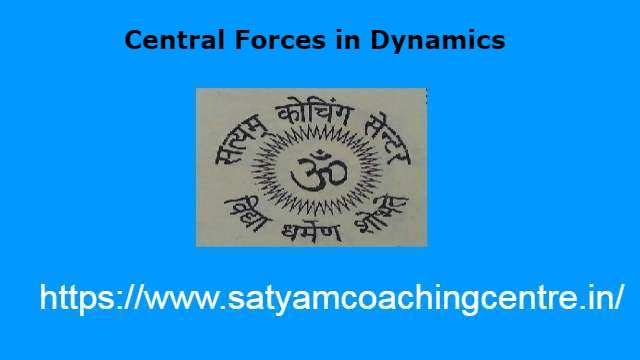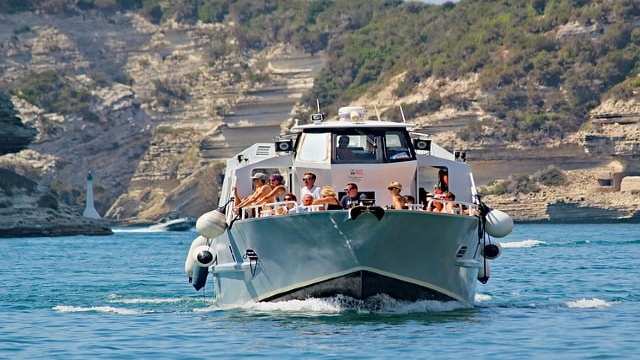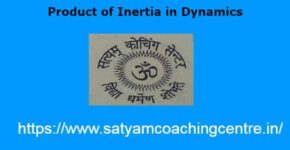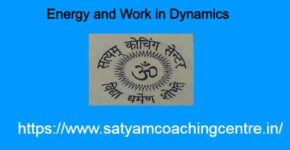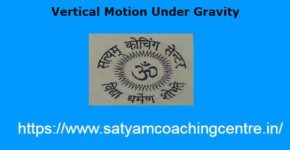Central Forces in Dynamics
1.गति विज्ञान में केन्द्रीय बल (Central Forces in Dynamics),केन्द्रीय बल (Central Forces):
गति विज्ञान में केन्द्रीय बल (Central Forces in Dynamics) वह कहलाता है जब एक कण किसी ऐसे बल के अधीन गमन करता है जिसकी दिशा सर्वदा एक नियत बिन्दु की ओर होती है।
आपको यह जानकारी रोचक व ज्ञानवर्धक लगे तो अपने मित्रों के साथ इस गणित के आर्टिकल को शेयर करें।यदि आप इस वेबसाइट पर पहली बार आए हैं तो वेबसाइट को फॉलो करें और ईमेल सब्सक्रिप्शन को भी फॉलो करें।जिससे नए आर्टिकल का नोटिफिकेशन आपको मिल सके । यदि आर्टिकल पसन्द आए तो अपने मित्रों के साथ शेयर और लाईक करें जिससे वे भी लाभ उठाए । आपकी कोई समस्या हो या कोई सुझाव देना चाहते हैं तो कमेंट करके बताएं।इस आर्टिकल को पूरा पढ़ें।
Also Read This Article:- Constrained Motions in Dynamics
2.गति विज्ञान में केन्द्रीय बल पर आधारित उदाहरण (Examples Based on Central Forces in Dynamics):
एक कण निम्न वक्र में केन्द्रीय बल P के अधीन चलता है,जहाँ बल केन्द्र ध्रुव है।प्रदर्शित कीजिए कि बल निम्न प्रकार है:
(A particle describes the following curves under a central force P,when pole is the centre of force.Show that the force is as follows):
Example:1(ii). r=a \cos n \theta, p \propto \left(\frac{2 n^2 a^2}{r^5}-\frac{n^2-1}{r^3}\right)
Solution: r=a \cos n \theta, p \propto \left(\frac{2 n^2 a^2}{r^5}-\frac{n^2-1}{r^3}\right) \\ 1=au \cos n \theta
दोनों पक्षों का लघुगणक लेकर \theta के सापेक्ष अवकलन करने पर:
\log (1)=\log a+\log u+\log \cos n \theta \\ \Rightarrow 0=0+\frac{1}{u} \frac{d u}{d \theta}-\frac{n \sin n \theta}{\cos n \theta} \\ \Rightarrow \frac{d u}{d \theta}=n u \tan n \theta
पुनः \theta के सापेक्ष अवकलन करने पर:
\frac{d^2 u}{d \theta^2} =n \frac{d u}{d \theta} \tan n \theta+n^2 u \sec ^2 n \theta \\ =n(n u \tan n \theta) \tan n \theta+n^2 u \sec ^2 n \theta \\ \Rightarrow \frac{d^2 u}{d \theta^2} =n^2 u \tan ^2 n \theta+n^2 u \sec ^2 n \theta
ध्रुव बिन्दु की ओर बल के अधीन संकेन्द्र कक्षा का अवकल समीकरण
\frac{P}{h^2 u^2} =\frac{d^2 u}{d \theta^2}+u \\ \Rightarrow \frac{P}{h^2 u^2} =n^2 u \tan ^2 n \theta +n^2 u \sec ^2 n \theta+u \\ =n^2 u\left(\sec ^2 n \theta-1\right)+n^2 u \sec ^2 n \theta+u \\ =n^2 u \sec ^2 n \theta-n^2 u+n^2 u \sec ^2 n \theta+u \\ =2 n^2 u \sec ^2 n \theta-n^2 u+u \\ =u \left[\frac{2n^2}{\cos ^2 n \theta}-\left(n^2-1\right)\right] \\ \Rightarrow P=h^2 u^3\left[\frac{2 n^2}{\cos ^2 n \theta}-\left(n^2-1\right)\right] \\ \Rightarrow P \propto \frac{1}{r^3}\left[\frac{2 n^2 a^2}{r^2}-\left(n^2-1\right)\right] \\ \Rightarrow P \propto \left(\frac{2 n^2 a^2}{r^5}-\frac{\left(n^2-1\right)}{r^3}\right)
Example:4. a u=\coth \left(\frac{\theta}{\sqrt{2}}\right) ; p \propto \frac{1}{r^5}
Solution: a u=\coth \left(\frac{\theta}{\sqrt{2}}\right) ; p \propto \frac{1}{r^5} \\ \theta के सापेक्ष अवकलन करने पर:
a \frac{d u}{d \theta} =-\operatorname{cosech}^2\left(\frac{\theta}{\sqrt{2}}\right) \cdot \frac{1}{\sqrt{2}} \\ \Rightarrow a \frac{d u}{d \theta} =-\frac{1}{\sqrt{2}} \operatorname{cosech}^2 \left(\frac{\theta}{\sqrt{2}}\right)
पुनः \theta के सापेक्ष अवकलन करने पर:
a \frac{d^2 u}{d \theta^2} =-\frac{1}{\sqrt{2}} \cdot 2 \operatorname{cosech}\left(\frac{\theta} {\sqrt{2}}\right)\left[-\operatorname{cosech}\left(\frac{\theta}{\sqrt{2}}\right) \coth \left(\frac{\theta}{\sqrt{2}}\right)\right]\frac{1}{\sqrt{2}} \\ =\operatorname{cosech}^2\left(\frac{\theta}{\sqrt{2}}\right) \coth \left(\frac{\theta}{\sqrt{2}}\right) \frac{1}{\sqrt{2}} \\ \Rightarrow \frac{d^2 u}{d \theta^2} =\frac{1}{a} \operatorname{cosech}^2\left(\frac{\theta}{\sqrt{2}}\right) \coth \left(\frac{\theta}{\sqrt{2}}\right) \\ =\frac{1}{a}\left[\coth^2\left(\frac{\theta}{\sqrt{2}} \right)-1\right] \coth \left(\frac{\theta}{\sqrt{2}}\right) \\ \Rightarrow \frac{d^2 u}{d \theta^2} =\frac{1}{a} \coth^3\left(\frac{\theta}{\sqrt{2}}\right)-\frac{1}{a} \coth \frac{\theta}{\sqrt{2}}
ध्रुव बिन्दु की ओर बल के अधीन संकेन्द्र कक्षा का अवकल समीकरण
Example:6. r=a \frac{\cosh \theta-1}{\cosh \theta+2} ; P \propto \frac{1}{r^4}
Solution: r=a \frac{\cosh \theta-1}{\cosh \theta+2} ; P \propto \frac{1}{r^4} \\ \Rightarrow \frac{1}{u} =a\left(\frac{\cosh \theta-1}{\cosh \theta+2}\right) \\ \Rightarrow u a =\frac{\cosh \theta+2}{\cosh \theta-1} \\ =\frac{(\cosh \theta-1)+3}{\cosh \theta-1} \\ \Rightarrow ua=1+\frac{3}{\cosh \theta-1} \\ \theta के सापेक्ष अवकलन करने पर:
a \frac{d u}{d \theta}=-\frac{3 \sinh \theta}{(\cosh \theta-1)^2}
पुनः \theta के सापेक्ष अवकलन करने पर:
a \frac{d^2 u}{d \theta^2}=\frac{-3\left[(\cosh \theta-1)^2 \cosh \theta-\sinh \theta \cdot 2 \left(\cosh \theta-1\right) \sinh \theta\right]}{(\cosh \theta-1)^4} \\ =\frac{-3(\cosh \theta-1) \left[(\cosh \theta-1) \cosh \theta-2 \sinh^2 \theta\right]}{(\cosh \theta-1)^4} \\ =\frac{-3\left(\cosh ^2 \theta-\cosh \theta-2 \sinh ^2 \theta\right)}{(\cosh \theta-1)^3} \\ =\frac{-3\left[\cosh ^2 \theta-\sinh ^2 \theta-\cosh \theta-\sinh ^2 \theta\right]}{(\cosh \theta-1)^3} \\ =\frac{-3\left[1-\cosh \theta-\left(\cosh ^2 \theta-1\right) \right]}{(\cosh \theta-1)^3} \\ =-3\left[\frac{(\cosh \theta-1)(-1-\cosh \theta-1)}{(\cosh \theta-1)^3}\right] \\ =3 \frac{\cosh \theta+2}{(\cosh \theta-1)^2} \\ \Rightarrow \frac{d^2 u}{d \theta^2}=\frac{3}{a} \left[\frac{\cosh \theta+2}{(\cosh \theta-1)^2}\right]
ध्रुव बिन्दु की ओर बल के अधीन संकेन्द्र कक्षा का अवकल समीकरण
\frac{P}{h^2 u^2} =\frac{d^2 u}{d \theta^2}+u \\=\frac{3}{a}\left[\frac{\cosh \theta+2}{(\cosh \theta-1)^2}\right]+\frac{1}{a} \left[\frac{\cosh \theta+2}{\cosh \theta-1}\right] \\ =\frac{1}{a} \left[\frac{3(\cosh \theta+2)+(\cosh \theta+2)(\cosh \theta-1)}{(\cosh \theta-1)^2}\right] \\ =\frac{1}{a}\left[\frac{(\cosh \theta+2)(3+\cosh \theta-1)}{(\cosh \theta-1)^2}\right] \\ =\frac{1}{a} \frac{(\cosh \theta+2)(\cosh \theta +2)}{(\cosh \theta-1)^2} \\ =\frac{1}{a} \frac{(\cosh \theta+2)^2}{(\cosh \theta-1)^2} \\ =\frac{1}{a}(a u)^2 \\ \Rightarrow P=a h^2 u^4 \\ \Rightarrow P \propto \frac{1}{r^4}
Example:8. a^2 u^2=\frac{\cosh 2 \theta+1}{\cosh 2 \theta-2} ; p \propto \frac{1}{r^7}
Solution: a^2 u^2=\frac{\cosh 2 \theta+1}{\cosh 2 \theta-2} ; p \propto \frac{1}{r^7}
दोनों पक्षों का लघुगणक लेने परः
\log \left(a^2 u^2\right)=\log \left(\frac{\cosh 2 \theta+1}{\cosh 2 \theta-2}\right) \\ \Rightarrow 2 \log a+2 \log u=\log (\cosh 2 \theta+1)-\log (\cosh 2 \theta -2) \\ \theta के सापेक्ष अवकलन करने परः
\Rightarrow 0+2 \cdot \frac{1}{u} \frac{d u}{d \theta}=\frac{2 \sinh 2 \theta}{\cosh 2 \theta+1}-\frac{2 \sinh 2 \theta}{\cosh 2 \theta-2} \\ \Rightarrow \frac{d u}{d \theta}=u\left(\frac{\sinh 2 \theta}{\cosh 2 \theta+1} -\frac{\sinh 2 \theta}{\cosh 2 \theta-2}\right)
पुनः \theta के सापेक्ष अवकलन करने परः
\frac{d^2 u}{d \theta^2}=\frac{d u}{d \theta}\left(\frac{\sinh 2 \theta}{\cosh 2 \theta+1}-\frac{\sinh 2 \theta}{\cosh 2 \theta-2}\right)+u \left[ \frac{(\cosh 2 \theta+1) \cdot 2 \cosh 2 \theta-\sinh 2 \theta \cdot 2 \sinh 2 \theta}{(\cosh 2 \theta+1)^2}-\frac{(\cosh 2 \theta-2) 2 \cosh 2 \theta-\sinh 2 \theta \cdot 2 \sinh 2 \theta}{(\cosh 2 \theta-2)^2} \right] \\ =\frac{d u}{d \theta} \cdot \sinh 2 \theta \left(\frac{\cosh 2 \theta-2-\cosh 2 \theta-1}{(\cosh 2 \theta+1)(\cosh 2 \theta-2)}\right)+u \left[\frac{2\left(\cosh ^2 2 \theta-\sinh ^2 2 \theta\right)+2 \cosh 2 \theta}{(\cosh 2 \theta+1)^2}- \frac{2\left(\cosh ^2 2 \theta-\sinh ^2 2 \theta \right) -4 \cosh 2 \theta}{(\cosh 2 \theta-2)^2}\right] \\ =\frac{d u}{d \theta} \frac{\sinh 2 \theta(-3)}{(\cosh 2 \theta+1)(\cosh 2 \theta-2)}+u \left[\frac{2+2 \cosh 2 \theta}{(\cosh 2 \theta+1)^2}-\frac{2-4 \cosh 2 \theta}{(\cosh 2 \theta-2)^2}\right] \\ =\frac{-3 \sinh 2 \theta}{(\cosh 2 \theta+1)(\cosh 2 \theta-2)} \times \frac{-3 u \sinh 2 \theta}{(\cosh 2 \theta+1)(\cosh 2 \theta-2)} +u\left[\frac{2}{\cosh 2 \theta+1} +\frac{4 \cosh 2 \theta-2}{(\cosh 2 \theta-2)^2}\right] \\ =\frac{9u \sinh^2 2 \theta}{(\cosh 2 \theta+1)^2(\cosh 2 \theta-2)^2} +2u\left[ \frac{\cosh ^2 2 \theta-4 \cosh 2 \theta \\+4+2 \cosh 2 \theta+ \cosh ^2 2 \theta-1}{(\cosh 2 \theta+1)(\cosh 2 \theta-2)^2} \right] \\ =\frac{9u \left(\cosh ^2 2 \theta-1\right)}{(\cosh 2 \theta+1)^2(\cosh 2 \theta-2)^2}+ 2 u\left[\frac{3 \cosh ^2 2 \theta-3 \cosh 2 \theta+3}{(\cosh 2 \theta+ 1)(\cosh 2 \theta-2)^2}\right] \\ =\frac{9 u(\cosh 2 \theta-1)}{(\cosh 2 \theta +1)(\cosh 2 \theta-2)^2} +6u\left[\frac{\cosh ^2 2 \theta-\cosh ^2 \theta +1}{\left(\cosh ^2 \theta+1 \right) \left(\cosh ^2 \theta-2\right)^2}\right] \\ =\frac{3 u}{(\cosh 2 \theta+1)(\cosh 2 \theta-2)^2} \left[3 \cosh 2 \theta-3 +2 \cosh ^2 2 \theta-2 \cosh 2 \theta+2 \right] \\ =\frac{3 u\left(2 \cosh ^2 2 \theta+ \cosh 2 \theta-1\right)}{(\cosh 2 \theta+1)(\cosh 2 \theta-2)^2} \\ =\frac{3 u(\cosh 2 \theta+1)(2 \cosh 2 \theta-1)}{(\cosh 2 \theta+1)(\cosh 2 \theta-2)^2} \\ =\frac{3 u(2 \cosh 2 \theta-1)}{(\cosh 2 \theta-2)^2} \\ \Rightarrow \frac{d^2 u}{d \theta^2}=\frac{3 u(2 \cosh 2 \theta-1)}{(\cosh 2 \theta-1)^2}
ध्रुव बिन्दु की ओर बल के अधीन संकेन्द्र कक्षा का अवकल समीकरण
\frac{P}{h^2 u^2} =\frac{d^2 u}{d \theta^2}+u \\ =\frac{3 u(2 \cosh 2 \theta-1)}{(\cosh 2 \theta-2)^2}+u \\ =u\left[\frac{6 \cosh 2 \theta-3}{(\cosh 2 \theta-2)^2}+1\right] \\ =u\left[ \frac{6 \cosh ^2 \theta-3+\cosh ^2 2 \theta-4 \cosh 2 \theta +u}{(\cosh 2 \theta-2)^2}\right] \\ =u\left[\frac{\cosh^2 2 \theta+2 \cosh 2 \theta+1}{(\cosh 2 \theta-2)^2}\right] \\ \Rightarrow P=h^2 u^3 \frac{(\cosh 2 \theta+1)^2}{(\cosh 2 \theta-2)^2} \\=h^2 u^3 \cdot a^4 u^4 \\ =h^2 a^4 u^7 \\ \Rightarrow P=\frac{h^2 a^4}{r^7}\left[\because u=\frac{1}{r}\right] \\ \Rightarrow P \propto \frac{1}{r^7}
Example:10.एक सकेन्द्र कक्षा दिए हुए केन्द्रीय बल के अधीन निर्मित होता है,इसके किसी भी बिन्दु पर वेग उसके बल केन्द्र से दूरी का व्युत्क्रमानुपाती है,प्रदर्शित कीजिए कि पथ एक समान कोणिक सर्पिल है।
(In an orbit described under a force to a centre,the velocity at any point in inversely proportional to the distance of the point from the centre of force, show that the path is an equiangular spiral.)
Solution: v=\frac{\mu}{r} (दिया है)
परन्तु v=\frac{h}{p}
(जहाँ p, O से स्पर्श रेखा पर लम्ब है)
\therefore \frac{h}{p}=\frac{\mu}{r} \\ \Rightarrow p=\frac{h r}{\mu} \\ \Rightarrow p=a r\left[\because a=\frac{h}{\mu}\right]
जो कि समानकोणिक सर्पिल का समीकरण है (पदिक समीकरण)।
उपर्युक्त उदाहरणों के द्वारा गति विज्ञान में केन्द्रीय बल (Central Forces in Dynamics),केन्द्रीय बल (Central Forces) को समझ सकते हैं।
3.गति विज्ञान में केन्द्रीय बल की समस्याएँ (Central Forces in Dynamics Problems):
एक कण निम्न वक्र में केन्द्रीय बल P के अधीन चलता है,जहाँ बल केन्द्र ध्रुव है।प्रदर्शित कीजिए कि बल निम्न प्रकार है:
(A particle describes the following curves under a central force P,when pole is the centre of force.Show that the force is as follows):
(1.) r^n=a^n \cos n \theta ; P \propto \frac{1}{r^{2 n+3}}
(2.) r^2=a^2 \cos 2 \theta ; P \propto \frac{1}{r^7}
उपर्युक्त सवालों को हल करने पर गति विज्ञान में केन्द्रीय बल (Central Forces in Dynamics),केन्द्रीय बल (Central Forces) को ठीक से समझ सकते हैं।
Also Read This Article:- Energy and Work in Dynamics
4.गति विज्ञान में केन्द्रीय बल (Frequently Asked Questions Related to Central Forces in Dynamics),केन्द्रीय बल (Central Forces) से सम्बन्धित अक्सर पूछे जाने वाले प्रश्न:
प्रश्न:1.दिए हुए सकेन्द्र कक्षा के समीकरण के लिए केन्द्रीय बल ज्ञात करने की विशेष स्थितियाँ लिखिए। (Write the particular cases to find the central forces for the given equation of central orbit):
उत्तर:केन्द्रीय बल P, बिन्दु की ध्रुवी दूरी के (2n+3) घातीय व्युत्क्रमानुपाती होगाः
P \propto \frac{1}{r^{2 n+3}}
विशेष स्थितियाँ (particular cases):
(1.)यदि n=1 तब वक्र (सकेन्द्र कक्षा) का समीकरण r=a \cos \theta अर्थात् वृत्त जिसकी परिधि पर एक बिन्दु ध्रुव है।इस स्थिति में
P \propto \frac{1}{r^5}
(2.)यदि n=2 तब वक्र (सकेन्द्र कक्षा) का समीकरण r^2=a^2 \cos 2 \theta अर्थात् बरनौली की द्विघाती (Lemniscate of Bernouilli)।इस स्थिति में
P \propto \frac{1}{r^7}
(3.)यदि n=-2 तब वक्र (सकेन्द्र कक्षा) का समीकरण r^2=a^2 \cos 2 \theta अर्थात् समकोणीय अतिपरवलय जिसका केन्द्र,ध्रुव है।इस स्थिति में P \propto -r चूँकि इस स्थिति में (n+1) ऋणात्मक है।इसलिए बल केन्द्रीय प्रतिकर्षी (repulsive) होगा।
(4.)यदि n=\frac{1}{2},तब वक्र (सकेन्द्र कक्षा) का समीकरण r=a \cos ^2 \left(\frac{\theta}{2}\right) या r=\left(\frac{a}{2}\right)(1+\cos \theta) अर्थात् कार्डियोइड।इस स्थिति में P \propto \frac{1}{r^4}
(5.)यदि n=-\left(\frac{1}{2}\right) तब वक्र (सकेन्द्र कक्षा) का समीकरण
r=\left\{\frac{a}{\cos ^2\left(\frac{\theta}{2}\right)}\right\}=\frac{2 a}{(1+\cos \theta)} \\ \Rightarrow \frac{2 a}{2}=1+\cos \theta
अर्थात् परवलय जिसकी नाभि ध्रुव है।इस स्थिति में
P \propto \frac{1}{r^2}
प्रश्न:2.सकेन्द्र कक्षा ज्ञात करो जबकि केन्द्रीय बल r का फलन हो। (Find central orbit when the central force is a function of r):
उत्तर:यदि केन्द्रीय बल नियत बिन्दु के दूरी के वर्ग व्युत्क्रमानुपाती हो,तो सकेन्द्र कक्षा ज्ञात करना।
(If the central force varies inversely as the square of the distance from a fixed point, to find the central orbit.)
यहाँ P=\frac{\mu}{r^2}
अब हम जानते हैं कि सकेन्द्र कक्षा का पदिक रूप में अवकल समीकरण
\frac{h^2}{p^3} \cdot \frac{d p}{d r}=P=\frac{\mu}{r^2} \cdots(1)
इस समीकरण का समाकलन करने पर:
\frac{h^2}{p^2}=\frac{2 \mu}{2} \cdots(2)
हम जानते हैं कि नाभि को ध्रुव लेने परः
(i)परवलय का पदिक समीकरण p^2=a r
(ii)दीर्घवृत्त का पदिक समीकरण \frac{b^2}{p^2}=\frac{2 a}{r}-1
(iii)अतिपरवलय का पदिक समीकरण \frac{b^2}{p^2}=\frac{2 a}{r}+1 होता है।
उपर्युक्त (ii) तथा (iii) समीकरणों की तुलना (2) से करने पर:
\frac{h^2}{b^2}=\frac{\mu}{a}=\frac{c}{\pm 1} \\ h=\sqrt{\left(\mu \frac{b^2}{a}\right)}=\sqrt{(\mu l)}, जहाँ l अर्धनाभिलम्ब है तथा c=\mp \frac{\mu}{a}
अतः कण का पथ c के ऋणात्मक अथवा धनात्मक होने के अनुसार दीर्घवृत्त अथवा परवलय होगा।
पुनः यदि c=0,(2) में प्रतिस्थापित करें तो \left(\frac{p^2}{r}\right)=अचर जो कि परवलय का पदिक समीकरण है,जिसका ध्रुव परवलय की नाभि पर है।अतः (2) कण का पथ c के प्रत्येक मान के लिए शांकव होगा जिसकी नाभि बल केन्द्र पर है।c के ऋणात्मक,शून्य अथवा धनात्मक होने के अनुसार दीर्घवृत्त,परवलय अथवा अतिपरवलय होगा।
प्रश्न:3.शांकव के किसी बिन्दु पर वेग के सूत्र लिखो।
उत्तर:शांकव के किसी बिन्दु पर वेग यदि v है,तो
v^2=\frac{h^2}{p^2}=\frac{2 \mu}{r}+c=\mu \left(\frac{2}{r}+\frac{1}{a}\right)
अतः दीर्घवृत्त के लिए v^2=\mu \left(\frac{2}{r}-\frac{1}{a}\right) अर्थात् v^2< \frac{2 \mu}{r}
परवलय के लिए v^2= \frac{2 \mu}{r} अर्थात् v^2= \frac{2 \mu}{r}
अतिपरवलय के लिए v^2=\mu \left(\frac{2}{r}+\frac{1}{a}\right) अर्थात् v^2> \frac{2 \mu}{r}
पुनः यदि अनन्त दूरी से उस बिन्दु तक गिरने के कण द्वारा प्राप्त वेग V है तो
\frac{d^2r}{d t^2}=\frac{d}{d r}\left(\frac{d r}{d t}\right)=v \frac{d v}{d r}=-P \\ \int_0^{v} v d v=\int_{-\infty}^a (-P) d r=-\int_{\infty}^{a} \left(\frac{\mu}{r^2}\right) dr \\ \therefore v^2=\frac{2 \mu}{r}
अतः कण का पथ दीर्घवृत्त,परवलय अथवा अतिपरवलय होगा यदि पथ के किसी बिन्दु पर वेग <=> अनन्त दूरी से उस बिन्दु तक गिरने से प्राप्त वेग के वर्ग से (अर्थात् v^2 से)
उपर्युक्त प्रश्नों के उत्तर द्वारा गति विज्ञान में केन्द्रीय बल (Central Forces in Dynamics),केन्द्रीय बल (Central Forces) के बारे में ओर अधिक जानकारी प्राप्त कर सकते हैं।
| No. | Social Media | Url |
|---|---|---|
| 1. | click here | |
| 2. | you tube | click here |
| 3. | click here | |
| 4. | click here | |
| 5. | Facebook Page | click here |
| 6. | click here |
Central Forces in Dynamics
गति विज्ञान में केन्द्रीय बल
(Central Forces in Dynamics)
Central Forces in Dynamics
गति विज्ञान में केन्द्रीय बल (Central Forces in Dynamics) वह कहलाता है जब एक कण
किसी ऐसे बल के अधीन गमन करता है जिसकी दिशा सर्वदा एक नियत बिन्दु की ओर होती है।
Related Posts
About Author
Satyam
About my self I am owner of Mathematics Satyam website.I am satya narain kumawat from manoharpur district-jaipur (Rajasthan) India pin code-303104.My qualification -B.SC. B.ed. I have read about m.sc. books,psychology,philosophy,spiritual, vedic,religious,yoga,health and different many knowledgeable books.I have about 15 years teaching experience upto M.sc. ,M.com.,English and science.
